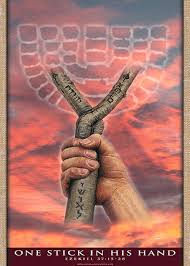Hosea 5:15–6:3, I will go and return to my place. This passage is a clear prophecy concerning the resurrection of the righteous dead of which Messiah Yeshua is the first to raise.
Verse two contains a Hebrew parallelism, which is a Hebraic literary device where the same thought is expressed differently back-to-back. The word revive is the Hebrew word chayah, which is the basic Hebrew root verb meaning “to live or to have life.” The word raise up is the Hebrew word quwm meaning “to rise, arise, stand, stand up.” According to TWOT, the basic meaning of this word “denotes rising up from a prostrate position (e.g. Josh 3:16).”
YHVH is speaking here in the broader context of this passage concerning his Messianic role as the lion of Judah (Rev 5:5). After presenting himself as such to both houses of Israel (Ephraim [i.e., the Christians] and Judah [i.e., the Jews]) at his first coming, verse 14 states that Messiah would “go away … and none shall rescue him.” Then in verse 15 we read that, “I [Messiah speaking] will go and return to my place till they [Ephraim and Judah] acknowledge their offense and seek my face ….” (This refers to Yeshua’s absence from the earth between his first and second comings.)
What is their offense? Isaiah 8:14 states that that which offends both houses of Israel is “the stone of stumbling and … rock of offense.” Who is this Rock of offense? Verses 8 and 10b identifies it as Immanuel (El with us), which is one of the titles of the Messiah (see Isa 7:14 and Matt 1:23). The Christians have stumbled over Yeshua, the Written Torah-Word of Elohim made flesh, saying that the Torah-law has been done away with, while the Jews have stumbled over Yeshua, the Living Torah, declaring that he can’t be the Messiah.
However, after two days (i.e., 2000 years) YHVH will revive us or resurrect the righteous dead of Ephraim and Judah or those who have been grafted into the olive tree (a metaphor for Israel, see Jer 11:16; Hos 14:6) or into the commonwealth of Israel through Messiah Yeshua (see Rom 11:16–26; Eph 2:11–19) at the end of the age. This occurs on the third day, or in the third millennia from the time of Messiah’s first coming (or approximately in the year 6000 from the beginning of creation) when he will raise up (or resurrect) the righteous redeemed of Ephraim and Judah at his second coming.
As Messiah Yeshua raised from the dead on the third day becoming the first of the first fruits to raise from the dead (1 Cor 15:20, 23), even so, he will resurrect his saints at his second coming on the third day (or the third millennia after his “going away” after his first coming). After that, he shall “go forth” and “shall come unto us” (i.e., the second coming) very much alive to lead his people during the Messianic Age (Millennium).



